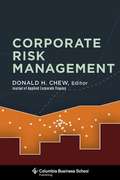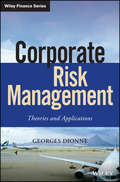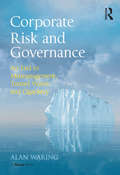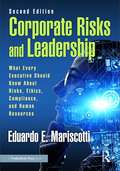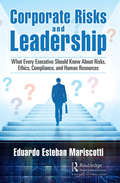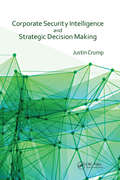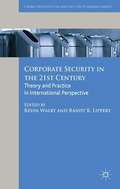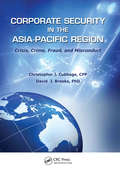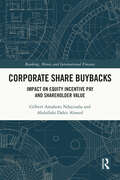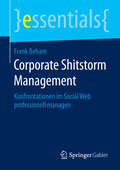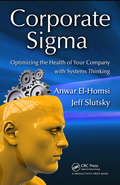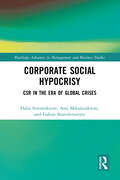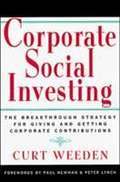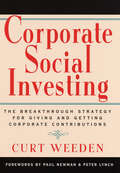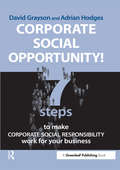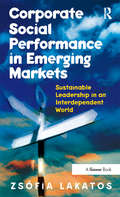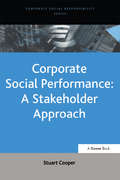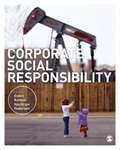- Table View
- List View
Corporate Risk Management: Strategies Management (Columbia Business School Publishing Ser.)
by Ed. Chew Donald H.More than thirty leading scholars and finance practitioners discuss the theory and practice of using enterprise-risk management (ERM) to increase corporate values. ERM is the corporate-wide effort to manage the right-hand side of the balance sheet-a firm's total liability structure-in ways that enable management to make the most of the firm's assets. While typically working to stabilize cash flows, the primary aim of a well-designed risk management program is not to smooth corporate earnings, but to limit the possibility that surprise outcomes can threaten a company's ability to fund its major investments and carry out its strategic plan. Contributors summarize the development and use of risk management products and their practical applications. Case studies involve Merck, British Petroleum, the American airline industry, and United Grain Growers, and the conclusion addresses a variety of topics that include the pricing and use of certain derivative securities, hybrid debt, and catastrophe bonds.Contributors: Tom Aabo (Aarhus School of Business); Albéric Braas and Charles N. Bralver (Oliver, Wyman & Company); Keith C. Brown (University of Texas at Austin); David A. Carter (Oklahoma State University); Christopher L. Culp (University of Chicago); Neil A. Doherty (University of Pennsylvania); John R. S. Fraser (Hyrdo One, Inc.); Kenneth R. French (University of Chicago); Gerald D. Gay (Georgia State University); Jeremy Gold (Jeremy Gold Pensions); Scott E. Harrington (University of South Carolina); J. B. Heaton (Bartlit Beck Herman Palenchar & Scott LLP); Joel Houston (University of Florida); Nick Hudson (Stern Stewart & Co.); Christopher James (University of Florida); A. John Kearney and Judy C. Lewent (Merck & Co., Inc.); Robert C. Merton and Lisa K. Meulbroek (Harvard Business School); Merton H. Miller (University of Chicago); Jouahn Nam (Pace University); Andrea M. P. Neves (CP Risk Management LLC); Brian W. Nocco (Nationwide Insurance); André F. Perold (Harvard Business School); S. Waite Rawls III (Continental Bank); Kenneth J. Risko (Willis Risk Solutions); Angelika Schöchlin (University of St. Gallen); Betty J. Simkins (Oklahoma State University); Donald J. Smith (Boston University); Clifford W. Smith Jr. (University of Rochester); Charles W. Smithson (Continental Bank); René M. Stulz (Ohio State University); D. SAll the articles that comprise this book were first published in the Journal of Applied Corporate Finance. Morgan Stanley's ownership of the journal is a reflection of its commitment to identifying outstanding academic research and promoting its application in the practicing corporate and investment communities.
Corporate Risk Management: Theories and Applications (Wiley Finance)
by Georges DionneAn updated review of the theories and applications of corporate risk management After the financial crisis of 2008, issues concerning corporate risk management arose that demand new levels of oversight. Corporate Risk Management is an important guide to the topic that puts the focus on the corporate finance dimension of risk management. The author—a noted expert on the topic—presents several theoretical models appropriate for various industries and empirically verifies theoretical propositions. The book also proposes statistical modeling that can evaluate the importance of different risks and their variations according to economic cycles. The book provides an analysis of default, liquidity, and operational risks as well as the failures of LTCM, ENRON, and financial institutions that occurred during the financial crisis. The author also explores Conditional Value at Risk (CVaR), which is central to the debate on the measurement of market risk under Basel III. This important book: Includes a comprehensive review of the aspects of corporate risk management Presents statistical modeling that addresses recent risk management issues Contains an analysis of risk management failures that lead to the 2008 financial crisis Offers a must-have resource from author Georges Dionne the former editor of The Journal of Risk and Insurance Corporate Risk Management provides a modern empirical analysis of corporate risk management across industries. It is designed for use by risk management professionals, academics, and graduate students.
Corporate Risk and Governance: An End to Mismanagement, Tunnel Vision and Quackery
by Alan WaringCorporate Risk and Governance addresses corporate risk management and governance requirements affecting large organizations in all industry sectors and countries. The book strongly advocates implementation of Corporate Governance Codes, ISO 31000 Risk Management, ISO 22301 Business Continuity Management and PAS 200 Crisis Management but warns against treating any standard or model slavishly, as if it can offer easy salvation or a simple route to a risk nirvana. Alan Waring challenges many hallowed beliefs, attitudes and practices that continue to hamper the delivery of effective Enterprise Risk Management (ERM) and thereby good governance. Those boardroom and corporate cultures that are complacent about risk exposures and risk management or, worse, encourage ’chancers’ and a ’what can we get away with’ attitude, are examined in depth along with what is required to embed a culture of responsible risk-taking. Some 75 cases from around the world provide graphic examples and lessons to be learned. Although the text includes some summary practical guidance, this book is designed primarily as a thinking aid rather than a risk management cookbook. It is something to encourage better informed risk-decision making; a more informed view of enterprise risk exposures, control and mitigation issues and an awareness of boardroom and corporate culture issues and their impact on effective ERM.
Corporate Risks and Leadership: What Every Executive Should Know About Risks, Ethics, Compliance, and Human Resources
by Eduardo E. MariscottiThe context of business has been changing for companies in recent years, and following numerous corporate and accounting scandals, many countries have increased the number of national and international regulations designed to ensure transparency and compliance with the law. Because of the existence of these new regulations, the level of control, the severity of sanctions by governments, and the amount of fines for noncompliance have increased dramatically.In parallel, with the technological revolution in communications, business management has become more transparent, and any negative event is uploaded to social networks and shared with an indeterminate number of people. This change in the regulatory, sanctioning, and technological context has forced large companies to rethink risks, investments, and budgets to deal with this more complex environment.To transition to this change, some companies have included ethics and compliance programs in their corporate agenda, along with marketing and sales plans, strategies, growth targets, investment plans, and/or talent acquisition. While each industry has its particular risks, in this book, the author describes the essential elements that any effective ethics and compliance program should contain.This book is a source of information that connects yesterday with today. The author shares observations and lessons of the past to suggest corporate leaders implement effective ethics and compliance programs to protect their organizations and themselves. This book covers theories of ethics but with an eye focused on practical application. Risks, ethics, and compliance are analyzed with an overall vision, connected to the reality of business life, without getting bogged down in abstract thinking or technical and regulatory details.Ethics and compliance are disciplines that have increasingly achieved greater recognition in organizations. Thus, due to the importance of risk management in the business world and the necessary involvement of the CEO and the board of directors, it seems appropriate that executives get access to this book about risks, ethics, compliance, and human resources directed not only to compliance experts but also to any organizational leader.This second edition offers various examples to cultivate ethical thinking and behavior, identify common risks, and comprehend their adverse effects on organizations.
Corporate Risks and Leadership: What Every Executive Should Know About Risks, Ethics, Compliance, and Human Resources
by Eduardo Esteban MariscottiThe context of business has been changing for companies in recent years, and following numerous corporate and accounting scandals, many countries have increased the number of national and international regulations designed to ensure transparency and compliance with the law. Because of the existence of these new regulations, the level of control, the severity of sanctions by governments, and the amount of the fines for noncompliance have increased dramatically. In parallel, with the technological revolution in communications, business management has become more transparent, and any negative event is uploaded to social networks and shared with an indeterminate number of people. This change in the regulatory, sanctioning and technological context has forced large companies to rethink risks, investments and budgets to deal in this more complex environment. To transition to this change, some companies have included ethics and compliance programs in their corporate agenda, along with marketing and sales plans, strategies, growth targets, investment plans and/or talent acquisition. While each industry has its particular risks, in this book, the author describes the essential elements that any effective ethics and compliance program should contain. This book is a source of information that connects yesterday with today. The author shares observations and lessons of the past to suggest corporate leaders implement effective ethics and compliance programs to protect their organizations and themselves. The book covers theories of ethics but with an eye focused on practical application. Risks, ethics, and compliance are analyzed with an overall vision, connected to the reality of business life, without getting bogged down in abstract thinking or in technical and regulatory details. Ethics and compliance are disciplines that have increasingly achieved greater recognition in organizations. Thus, due to the importance of risk management in the business world and the necessary involvement of the CEO and the board of directors, it seems appropriate that executives get access to a book about risks, ethics, compliance and human resources directed not only to compliance experts but also to any organizational leader. This book is a wake-up call that allows business leaders to understand the benefits of implementing an effective ethics and compliance program that will help members of organizations to make the right decisions and act within the law. If they do, they can better prevent and react to the difficult obstacle course of risks, dangers and threats that organizations face and that may jeopardize the sustainability, resilience, and survival of companies.
Corporate Sector Restructuring
by Mark R. StoneExamines the steps involved in restructuring the corporate sector. Large-scale corporate restructuring made necessary by a financial crisis is one of the most daunting challenges faced by economic policymakers. The government is forced to take a leading role, even if indirectly, because of the need to prioritize policy goals, address market failures, reform the legal and tax systems, and deal with the resistance of powerful interest groups.
Corporate Security Intelligence and Strategic Decision Making
by Justin CrumpDespite a clear and compelling need for an intelligence-led approach to security, operational, and reputational risks, the subject of corporate security intelligence remains poorly understood. An effective intelligence process can directly support and positively impact operational activity and associated decision-making and can even be used to driv
Corporate Security in the 21st Century
by Kevin Walby Randy K. LippertThis interdisciplinary collection places corporate security in a theoretical and international context. Arguing that corporate security is becoming the primary form of security in the twenty-first century, it explores a range of issues including regulation, accountability, militarization, strategies of securitization and practitioner techniques.
Corporate Security in the Asia-Pacific Region: Crisis, Crime, Fraud, and Misconduct
by Christopher J. Cubbage CPP David J. Brooks PhDAs corporations and governments become more litigious and risk averse, international risk management becomes more complex. Corporate Security in the Asia-Pacific Region: Crisis, Crime, Fraud, and Misconduct examines real cases of corporate crisis, crime, fraud, and other misconduct that corporate security professionals need to be aware of to effect
Corporate Semantic Web: Wie semantische Anwendungen in Unternehmen Nutzen stiften (X.media.press)
by Börteçin Ege Bernhard Humm Anatol ReiboldCorporate Semantic Web - hierbei geht es um semantische Anwendungen, deren Einsatz für Kunden und Mitarbeiter von Unternehmen konkret Nutzen stiftet. Die Autoren, namhafte Experten aus Industrie und Wissenschaft, berichten über ihre Erfahrungen bei der Entwicklung solcher Anwendungen. Sie gehen auf Software-Architektur, Methodik, Linked Open Data Sets, Lizenzfragen und Technologieauswahl ein und präsentieren auch eine Marktstudie. Vorgestellt werden Anwendungen für die Branchen Telekommunikation, Logistik, verarbeitende Industrie, Energie, Medizin, Tourismus, Bibliotheks- und Verlagswesen sowie Kultur. Der Leser erhält so einen umfassenden Überblick über die Einsatzbereiche des Semantic Web sowie konkrete Umsetzungshinweise für eigene Vorhaben.
Corporate Share Buybacks: Impact on Equity Incentive Pay and Shareholder Value (Banking, Money and International Finance)
by Gilbert Amahoro Ndayisaba Abdullahi Dahir AhmedThis book integrates elements from agency theory and signalling theory and draws upon recent changes in the Australian payout policy and incentives pay for risk-averse employees to provide theoretical and empirical analyses that explain the paradox of the popularity of on-market stock buyback activities in a market environment characterised by reasonably high share prices. The authors utilise a dynamic model that rationalises this paradox, which is divided into three components. The first component predicts that executives may be conducting on-market stock buyback programmes (SBPs) to adjust equity-based remuneration for risk-averse employees, thereby motivating their performance without granting them additional costly equity incentive plans (EIPs); the second component predicts that companies are likely to invest in SBPs to increase the ownership stakes of employees in the firm, thereby inducing risk-averse employees to increase their productivity which increases firm value; while the third component predicts that shareholders would benefit from incentives-induced buybacks if a firm’s opportunity cost of funds spent on buybacks is less than its inverse price-to-earnings ratio. The authors’ findings highlight differences in the market responses towards announced repurchase motives, implying that not all incentives-induced buybacks are value-destructive buybacks. Specifically, the widespread assumption that SBPs stifle investments in human and capital stock may be subjective as the findings show that incentives-induced buybacks may be value-creative or value-destructive depending on share repurchase motives of SBPs. This book will be a useful guide for scholars and researchers of finance, corporate finance, financial economics and financial accounting.
Corporate Shitstorm Management: Konfrontationen im Social Web professionell managen (essentials)
by Frank BehamDas Essential vermittelt in kompakter Form Handlungsempfehlungen für Unternehmen, die mit einem Shitstorm konfrontiert sind. Auf der Basis einer Untersuchung von sieben Shitstorms stellt Frank Beham wirksame Maßnahmen zur frühzeitigen Erkennung eines Shitstorms vor und steckt einen Handlungsrahmen zur adäquaten Reaktion ab. Darüber hinaus wird der Leser befähigt, das Gefährdungspotenzial und die Konsequenzen eines Shitstorms abzuschätzen. Dieses Buch kann jedem Unternehmen nutzen, das im Social Web präsent ist, und gibt wertvolle Hinweise, wie zukünftige Konfrontationen professionell bewältigt werden können.
Corporate Sigma: Optimizing the Health of Your Company with Systems Thinking
by Anwar El-Homsi Jeff L. SlutskyOne study after the next shows that most employees are unhappy with their jobs and that less than a third actively engage with their work. That means that two out of every three are merely putting in their time, rather than maximizing productivity and attaining satisfaction. One could argue that such a malaise is the symptom of an unhealthy workfor
Corporate Social Disclosure
by Carlos NoronhaCorporate Social Disclosure focuses on China and Japan as two countries for critical observations of the latest CSD issues. This volume consists of 12 chapters written by scholars from these two countries, addressing the latest observation of CSD in general as we as in different industries based on their latest research findings.
Corporate Social Entrepreneurship
by Christine A. HemingwayBusiness ethics teaching appears to have had little impact, particularly in the light of continued malpractice and misdemeanour in the form of financial scandals, environmental disasters and adverse consequences for communities. This timely book directly addresses a central question: is it that the existence of an ethical or an unethical climate influences behaviour, or, does the presence or absence of a moral character and personal values have the greatest influence on behaviour at work? Drawing on an empirically derived study and over thirty years of experience in both the public and private sectors, Hemingway proposes four modes of individual moral commitment to corporate social responsibility (CSR) and sustainability: the Active Corporate Social Entrepreneur, the Concealed Corporate Social Entrepreneur, the Conformist and the Disassociated. The discovery of the corporate social entrepreneur offers students and scholars a critical, alternative and optimistic perspective for the future of ethical business.
Corporate Social Hypocrisy: CSR in the Era of Global Crises (Routledge Advances in Management and Business Studies)
by Asta Mikalauskienė Dalia Steimikiene Gabija StanislovaitytėMany new challenges including competitiveness are emerging for sustainable business during this era of disruption. This book analyses these challenges to sustainable development and growth and addresses the impact of corporate social responsibility on the competitiveness of organisations. The authors analyze the major challenges for competitiveness of sustainable business in the COVID-19 era, taking into account a new business environment amid major global risks and uncertainties linked to climate change, pandemics, Russian-Ukrainian war, and intuitions of forthcoming new world economic crisis. The monograph consists of five parts: 1) sustainable development goals and the role of business; 2) climate change, COVID-19, fragile political situation, and business; 3) corporate social responsibility and corporate social hypocrisy; 4) corporate social responsibility, corporate social hypocrisy, and competitiveness of business; and 5) case study on the impact of corporate social responsibility on competitiveness with the impediments of corporate social hypocrisy. The book presents new insights in assessing the impact of CSR on competitiveness of companies with the impediments of corporate social hypocrisy. The developed framework and case study allows to develop valuable policy and managerial implications for sustainable business and engagements in corporate social responsibility as well as to show the danger of corporate social hypocrisy for competitiveness. This book will be of value to researchers, academics, and students in the fields of corporate social responsibility, organizational management, business ethics, and responsible business.
Corporate Social Investing: Breakthrough Strategy for Giving and Getting Corporate Contributions
by Curt WeedenThis is an advanced strategy for giving and getting corporate contributions with various depictions through calculations on the basis of situations from actual economical and statistical world.
Corporate Social Investing: The Breakthrough Strategy for Giving & Getting Corporate Contributions
by Curt WeedenDetails a practical, 10-step plan that can create exciting new relationships between businesses and nonprofits Weeden's plan could generate an additional $3 billion a year in corporate support for vital causes, improving quality of life for millions, while at the same time bolstering corporate profits Offers essential advice for businesses planning their corporate social investing strategies and nonprofits seeking corporate support Corporate philanthropy is on its way out. A new concept called "corporate social investing"-which requires that every commitment of money and/or product/equipment/land which a company makes must have a significant business reason-is taking its place. The transition has implications to every business and nonprofit organization in America. This book provides the strategic plan for making the transition to corporate social investing. By following the practical steps described here, businesses and nonprofits can forge creative alliances that can boost corporate profits while at the same time providing added resources for schools, colleges, cultural organizations, civic groups, and other important charities. Weeden's breakthrough plan, based on his innovative concept of corporate social investing, has the potential to dramatically change the way businesses and nonprofits interact. If widely implemented, it could substantially increase corporate support for nonprofits, turning the tide against cutbacks, offering profound benefits to businesses, and revitalizing the essential services nonprofits provide.
Corporate Social Irresponsibility
by Paula AlexanderCorporate Social Irresponsibility focuses on ethical failures in order to relate corporate responsibility to business ethics, corporate governance, and organization effectiveness. The book advocates a strategic approach to CSR – ethical management cannot, and should not, be divorced from effective management. Corporate social responsibility has transitioned from oxymoron into a defining challenge of the twenty first century. Taking the recent financial crisis as a starting point, Alexander examines the underlying ethical and legal crises these events expose in the business world. The problems that have come to light go beyond issues of firm financial performance into the integrity of the manufacturing and marketing processes, and relations with consumers. As such, the book presents a model that resolves the apparent conflict between maximizing shareholder value, and meeting the interests of other firm stakeholders. Alexander presents a balanced view, contrasting her model with alternative approaches. The book also covers the impact of globalization on management, the ethics of outsourcing, the limits of regulation, as well as poverty alleviation and social entrepreneurship. Blending a comprehensive theoretical framework with a broad range of cases, this book covers the latest major changes in US legislation, as well as recent corporate scandals making it a valuable accompaniment to any course in CSR, business ethics, or business, government and society.
Corporate Social Opportunity!: Seven Steps to Make Corporate Social Responsibility Work for your Business
by David Grayson Adrian HodgesThis practical guide is designed to help business leaders and their managers understand how to assess the impact of corporate social responsibility factors on their core business strategy and operations, and help them identify and prioritize between subsequent options and resulting business opportunities
Corporate Social Performance in Emerging Markets: Sustainable Leadership in an Interdependent World
by Zsófia LakatosWhen it comes to perceptions of what is a sustainable economy and how it may be realised, companies expanding into Central and Eastern European markets face the challenge of diverse people, attitudes and history. Corporate Social Performance in Emerging Markets provides an effective tool for companies to help them engage in CSR activities and become a responsible company in CEE countries such as Poland, Hungary, the Czech Republic, Slovakia, Croatia and Slovenia. It does this by enabling them to focus on the difference of stakeholders and their attitudes to those of Western Europe. The author, Zsófia Lakatos, provides a review of the major differences between the various CEE countries, supported by interview research from leading executives in some of the blue-chip companies already operating in the region.
Corporate Social Performance: A Stakeholder Approach (Corporate Social Responsibility Series)
by Stuart CooperCorporate social performance has come of age. In a business environment characterized by its perpetual state of flux, the ability to recognize and react to global forces becomes paramount. The fallout of such rapid change - the fast-paced developments in communications and technology, the continual change to global markets, shifting demographics, the homogenization of personal values - have all contributed to the widespread new interest in issues such as ecology and environment, human rights and diversity, health and well-being, and communities. All of these issues are now potential liabilities for companies, and are very much back on the agenda for business. Once regarded as peripheral management concerns, they are now recognized as hard to predict and hard for business to deal with when they go wrong. This book offers an insight into how corporate social performance can be measured and why this is an important aspect of corporate social responsibility. Using detailed case studies, it provides readers with the foundations for understanding and applying corporate social performance, providing a stakeholder framework by which corporate social performance can be measured, alongside a detailed consideration of the value of different stakeholder measures. The book also applies this framework to new social accounting standards, enabling the reader to consider the validity and appropriateness of these standards. The increasingly important role of the internet for corporate social reporting is also considered.
Corporate Social Responsibility
by Mette Morsing Andreas Rasche Jeremy MoonAlthough the idea of social responsibility has a long and distinguished intellectual pedigree, Corporate Social Responsibility (or 'CSR') has re-emerged during the last fifteen years or so as a high-profile concept in both academia and business practice. This revitalized interest has come about largely because of the development of the 'markets for virtue' that have institutionalized CSR in business practices in an unprecedented manner. CSR has achieved organizational distinctiveness within companies (e. g. in managerial and board responsibilities); social and environmental reporting requirements have dramatically increased; socially responsible investment funds have not only established themselves in their own right, but have also informed more mainstream investment criteria, particularly regarding social and environmental risk; a CSR consultancy industry has emerged, along with various 'vanguard groups' and NGOs who seek not only to promote CSR, but also to bring critical perspectives to bear and to raise CSR standards; and governments around the globe have encouraged investment in CSR, better reporting of these activities, and the implementation of CSR initiatives that complement broader public policies. As research in and around CSR blossoms as never before, this new four-volume collection from Routledge's acclaimed Critical Perspectives on Business and Management series meets the need for an authoritative reference work to make sense of a rapidly growing and ever more complex corpus of literature. Edited by two scholars from Nottingham University's world-class International Centre for Corporate Social Responsibility, the collection gathers foundational and canonical work, together with innovative and cutting-edge applications and interventions. With a full index, together with a comprehensive introduction, newly written by the editors, which places the collected material in its historical and intellectual context, Corporate Social Responsibility is an essential work of reference. The collection will be particularly useful as an essential database allowing scattered and often fugitive material to be easily located. It will also be welcomed as a crucial tool permitting rapid access to less familiar--and sometimes overlooked--texts. For researchers, students, practitioners, and policy-makers, it is as a vital one-stop research and pedagogic resource.
Corporate Social Responsibility
by Esben Rahbek Pedersen*Shortlisted in the Management and Leadership Textbook Category at CMI Management Book of the Year Awards 2016* Instructors - Electronic inspection copies are available or contact your local sales representative for an inspection copy of the print version. Why has CSR become part of the mainstream business and academic agenda in the 21st century? How can CSR be fully integrated in business strategy and day-to-day operations? Do companies become more vulnerable to criticism from stakeholders if they make public their commitment to CSR? These are just some of the questions and challenges explored in this exciting new textbook. Readers will not only gain comprehensive knowledge and understanding of the history of CSR, the key CSR drivers, the main theoretical CSR perspectives and the dominant CSR practices found in the business community, they will also, more crucially, learn how to implement CSR in practice. Written and edited by leading academics in the field, Corporate Social Responsibility is an engaging and accessible text designed for any student seeking an introduction to this complex and ambiguous subject. Esben Pedersen is Professor at the CBS Center for Corporate Social Responsibility, Copenhagen Business School. Visit the Companion Website at (https://study.sagepub.com/pedersen) for annotated web links, free full-text journal articles and more.
Corporate Social Responsibility
by Esben Rahbek PedersenWhy has CSR become part of the mainstream business and academic agenda in the 21st century? How can CSR be fully integrated in business strategy and day-to-day operations? Do companies become more vulnerable to criticism from stakeholders if they make public their commitment to CSR? These are just some of the questions and challenges explored in this exciting new textbook. Readers will not only gain comprehensive knowledge and understanding of the history of CSR, the key CSR drivers, the main theoretical CSR perspectives and the dominant CSR practices found in the business community, they will also, more crucially, learn how to implement CSR in practice. Written and edited by leading academics in the field, Corporate Social Responsibility is an engaging and accessible text designed for any student seeking an introduction to this complex and ambiguous subject. Esben Pedersen is Professor at the CBS Center for Corporate Social Responsibility, Copenhagen Business School. Visit https://study.sagepub.com/pedersen for annotated web links, free full-text journal articles and more.
